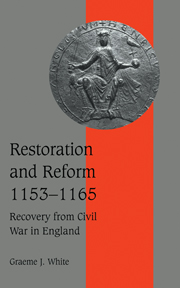Book contents
- Frontmatter
- Contents
- Preface
- List of abbreviations
- 1 The political context
- 2 The governance of England during Stephen's reign
- 3 Personnel and property
- 4 Financial recovery
- 5 The administration of justice
- 6 Conclusion
- Appendix I sheriffs' farms, 1130–65 and 1197
- Appendix II pipe roll, 11 Henry II (1164–5)
- Select bibliography
- Index
- Cambridge Studies in Medieval Life and Thought Fourth series
Appendix I - sheriffs' farms, 1130–65 and 1197
Published online by Cambridge University Press: 03 September 2009
- Frontmatter
- Contents
- Preface
- List of abbreviations
- 1 The political context
- 2 The governance of England during Stephen's reign
- 3 Personnel and property
- 4 Financial recovery
- 5 The administration of justice
- 6 Conclusion
- Appendix I sheriffs' farms, 1130–65 and 1197
- Appendix II pipe roll, 11 Henry II (1164–5)
- Select bibliography
- Index
- Cambridge Studies in Medieval Life and Thought Fourth series
Summary
The financial year ran from Michaelmas to Michaelmas. In the lists below, a date refers to the twelve months ending at Michaelmas in that year (e.g. ‘1156’ means Michaelmas 1155 to Michaelmas 1156). Against each total, the designations ‘blanch’, ad pensum or numero are taken from specifications in the pipe rolls; where sums were unqualified, as was sometimes the case in the early pipe rolls of Henry II's reign, allowances out have been assumed to be numero, but amounts paid in, owing or in surplus have been assumed as ‘blanch’ unless known to be otherwise. In calculating ‘blanch farms’, allowances numero have been converted to ‘blanch’ by subtracting at a rate of one shilling in the pound; this was the practice set out in Dialogus, 125, and (from comparison of calculations with stated totals) was clearly the method in operation in 1197 (9 Richard I), the first year when totals were given at the heads of each sheriff's farm account. Halfpence have been rounded up to the nearest penny.
Figures for several sheriffs' farms early in Henry II's reign have appeared elsewhere, notably in G. J.Turner, ‘The sheriff's farm’, TRHS, new series 12 (1898), 142–9, and in Amt, Accession, 198–204. Totals for 1130 were given in Ramsay, Revenues, 1, 61, and for 1164 in W. Parow, Compotus vicecomitis.
- Type
- Chapter
- Information
- Restoration and Reform, 1153–1165Recovery from Civil War in England, pp. 220 - 226Publisher: Cambridge University PressPrint publication year: 2000



